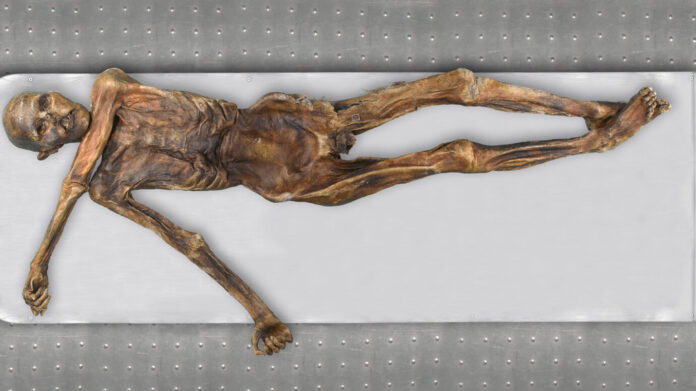Since his remains were discovered on 19 September 1991 in the Ötztal Alps at the border between Austria and Italy, the mummified “Ötzi” has been picked over and analysed by researchers from a variety of fields. There came a point where we thought we knew everything about him, from the way he looked to the food he ate, and even how he potentially died. Visitors to the South Tyrol Museum of Archaeology in Bolzano, Italy where his mummified remains are housed can even see a full reconstruction of Ötzi”, a light-skinned man sporting luscious brown locks.
New research

In 2012, twenty-one years after his remains were discovered, scientists compiled a complete picture of Ötzi’s genome; it suggested that he had ancestors from the Caspian steppe (SN: 2/28/12). But something didn’t add up.
The Iceman is about 5,300 years old. Other people with steppe ancestry didn’t appear in the genetic record of central Europe until about 4,900 years ago. Ötzi “is too old to have that type of ancestry,” says archaeogeneticist Johannes Krause of the Max Planck Institute for Evolutionary Anthropology in Leipzig, Germany. The mummy “was always an outlier.”
Now new DNA analysis published in “Cell Genomics” is absolutely destroying that initial image of Ötzi. After remapping over 90% of the Iceman’s genetic code through cutting-edge, comprehensive methods, scientists revealed a remarkable finding: a staggering 92% of Ötzi’s genetic lineage originates from the early Anatolian farmers who commenced their migration from what is now modern-day Turkey approximately 8000 years ago. This stands as the most significant proportion of Anatolian ancestry ever identified in an ancient European from Ötzi’s era. The remaining 8% of his genetic makeup can be traced back to a distinct group of hunter-gatherers from Western Europe. The researchers also determined that the last known interaction between these two groups occurred approximately 56 generations before Ötzi’s demise.
The conclusion is that instead of the way he looks in that recreation, Ötzi would instead have had much darker skin, and would have been exhibiting male pattern baldness. This lines up with other research which revealed that the genes for light skin tones didn’t become prevalent until 4,000 to 3,000 years ago when early farmers started eating plant-based diets and didn’t get as much vitamin D from fish and meat as hunter-gathers did.
His genetics also revealed a predisposition for a few very modern conditions, diabetes and obesity.


